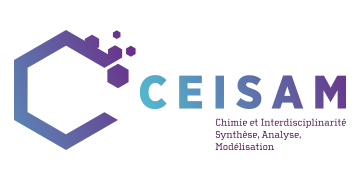Prof. Jerry MEYER from UNC Chapel Hill and director of CHASE will be giving a lecture at the CEISAM laboratory on Wednesday December 6th at 10h30 in Marie Curie room.
The title of his talk is: “Solar Energy Conversion with Molecular-Semiconductor Hybrid Photoelectrodes”.
Abstract
CHASE: Solar Energy Conversion with Molecular-Semiconductor Hybrid Photoelectrodes
Gerald J. Meyer
University of North Carolina at Chapel Hill, Chapel Hill NC 27599
The quest for hybrid photoelectrodes that efficiently upgrade abundant feedstocks to high energy fuels that can be stored is of critical importance. Recently a Solar Hub entitled the Center for Hybrid Approaches in Solar Energy to Liquid Fuels, or CHASE, was funded by the US Department of Energy to advance the fundamental science necessary to realize hybrid photoelectrodes based on molecular catalysts integrated with semiconducting electrodes, see: https://chaseliquidfuels.org/ This presentation will focus on recent mechanistic advances on individual electron transfer and proton coupled electron transfer (PCET) reactions relevant to photochemistry and to photocatalysis (1,2). Recent advances in our mechanistic understanding of dye-sensitized electron transfer reactions occurring in fluid solution and at metal oxide interfaces are manifold and were enabled by the advent of mesoporous thin films, comprised of anatase TiO2 nanocrystallites, that are amenable to spectroscopic and electrochemical characterization in unprecedented molecular-level detail. The metal-to-ligand charge transfer (MLCT) excited states of Ru polypyridyl compounds typically serve as the dye-sensitizers. Excited-state injection into TiO2 often occurs on ultrafast timescales with yields that can be tuned from unity to near zero through modification of the sensitizer or
the electrolyte composition. Transport of the injected electron and the oxidized sensitizer (hole-hopping) are both operative in the composite mechanism for charge recombination between the injected electron and the oxidized sensitizer. Sensitizers that contain a pendant electron donor,as well as core/shell TiO2/SnO2 nanostructures, often prolong the lifetime of the injected electron and provide fundamental insights into adiabatic and non-adiabatic electron transfer mechanisms. Regeneration of the oxidized sensitizer by iodide is enhanced through halogen bonding, orbital pathways, and ion-pairing. A significant ~ 10 MV cm–1 electric field is created by electron injection into TiO2 nanocrystallites that induces ion migration, reports on the sensitizer dipole orientation, and (in some cases) re-orients or flips the sensitizer. The utilization of conductive oxides also promotes long-lived charge separation with applied bias dependent kinetics that provide quantitative values of the reorganization energies associated with electron transfer and proton-coupled electron transfer (PCET) reactions occurring within the electric double layer(3). The impact of these findings on solar energy conversion will be discussed.
1. Perspectives in Dye Sensitization of Nanocrystalline Mesoporous Thin Films. Hu, K.; Sampaio, R.N.; Schneider,J.; Troian-Gautier, L.; Meyer, G.J. J. Am. Chem. Soc. 2020, 142, 16099-16116.
2. Dye-Sensitized Solar Cells Strike Back. Munoz-Garcia, A.; Benesperi, I.; Boschloo, G.; Concepcion, J.; Delcamp, J.;Gibson, E.; Meyer, G.J; Pavone, M.; Pettersson, H.; Hagfeldt, A.; Freitag, M. Chem. Soc. Rev. 2021, 50, 12450-12550.
3. Electronic Coupling and Reorganization Energies for Interfacial Proton-Coupled Electron Transfer to a Water Oxidation Catalyst. Kessinger, M.; Soudackov, A.; Schneider, J.; Bangle, R.E.; Hammes-Schiffer, S.; Meyer, G.J. J. Am. Chem. Soc. 2022, 144, 20514-20524.
Contact : Fabrice ODOBEL

